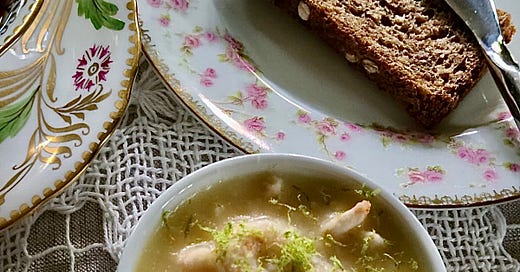“It has always been easy to hate and destroy. To build and to cherish is much more difficult."
Queen Elizabeth II
In a world awash with the sheer noise and volume of “stuff,” much of it inconsequential, we were all caught up in a moment of stillness with the death of Her Majesty Queen Elizabeth II this week.
There were few figures in our modern world that had such a global presence and recognition. A diminutive figure, the Queen learned early that bright clothing and show-stopping hats would make her stand out in any crowd. An unlikely fashion icon, the counterpoint to Iris Apfel, it seems certain we will never see someone donning that rainbow palette with such fitting charm again.
The Queen carried a mantle of complication. A descendant of a monarchy that ruled over a troubling history with its Commonwealth nations, Her Majesty inherited centuries of tradition and carried them on her strong shoulders with deeply ingrained duty, stability, wisdom and grace.
Much has been written about the Queen, especially in these past few days, as people reflect on her legacy, impact, and speculate about the monarchy’s future. If you have been like me, you may well have pored over the many tributes, the stories recounted of personal moments, the prognosticators who are trying to predict how King Charles will reign, or indeed if he even should.
A life captured in endless detail
Most of all it is the countless photos that have fascinated me. A life documented moment by moment, scrutinized in minute detail. A friend noted this week that the Queen was undoubtedly the most photographed woman in history. As I looked at Her Majesty’s life unfolding before me in a never-ending photo stream, I’ve been thinking about why her death has stirred up so much emotion - both positive and negative - and why her presence still holds sway. And I’ve been struck by one word above all others.
con·stan·cy
/ˈkänstənsē/
noun
the quality of being faithful and dependable
the quality of being enduring and unchanging
This above all else, defined the Queen. Constancy, along with its attendant meanings - fidelity, faithfulness, trueness, devotion, loyalty, trustworthiness - is a rare quality. Rare in that it is hard to maintain with such rigor and steadfastness. All of us are certainly capable of moments of grace, feel a sense of devotion to our family and friends, can be loyal and trustworthy. But to be able to be so reliably consistent under lifelong scrutiny is a tall order. That’s especially true as we see the fallibility of so many of those who aspire to lead us. It is this that has inspired my deep feeling of sadness at the Queen’s death.
“It’s worth remembering that it is often the small steps, not the giant leaps, that bring about the most lasting change."
Queen Elizabeth II
The Queen was no paragon of virtue. Nor did she choose her life’s vocation. But that she shouldered the mantle with a deep sense of what was expected of her, what was needed in the moment, was never at doubt. She did not always make the right decision. But I believe she demonstrated that she tried to make choices rooted in the greater good, knowing that small steps can heal in ways not immediately apparent in the moment.
One story in particular resonated with me this week:
I always thought of Queen Elizabeth as an avatar of nepotism and colonialism. But as time went on, and victimhood became the fashion, I began to have a creeping admiration for her stoicism.
Then, in 2011, I covered her fraught trip to Ireland, the first by a British monarch in a century. Suddenly I understood how one small movement of her head could soothe over 800 years of bloodshed and hatred.
The Irish were skeptical at first, not wanting to be treated as subjects. Gerry Adams complained the visit was too soon. (Maybe wait another century.) The queen’s guards were skeptical, too. She had the tightest security ever on the island.
How could Queen Elizabeth move past the 1979 murder by the I.R.A. of her cousin Lord Mountbatten and his 14-year-old grandson? Some officials in the Irish government, after all, were former I.R.A. capos.
And how could the Irish move past the 1972 Bloody Sunday horror, when British forces gunned down 14 innocent civilians?
The queen spoke a phrase in perfect Gaelic and offered regret about how Britain had made Ireland suffer. She said both sides needed to be “able to bow to the past but not be bound by it.”
She visited the Garden of Remembrance, a memorial to Irish patriots who died battling for independence, laying a wreath and bowing her head. She paid sartorial tribute with outfits by her Irish dressmaker: a gown featuring 2,091 hand-sewn shamrocks, hats trimmed in green feathers, an Irish harp brooch made of Swarovski crystals, ladies-in-waiting in 50 shades of green.
The queen showed all the empathy and warmth she could not summon when Diana died. By the end of the visit, the Irish had melted. They were calling Elizabeth their “prodigal mother,” “Liz,” and some were even waving Union Jacks. Her Irish guard of honor gave her the moniker “Eilis A Do,” Gaelic for Elizabeth II.
Maureen Dowd, The New York Times
Regardless of where you stand on the Queen - and I realise it’s many layered and divisive - I’d like to think that we can all agree that Her Majesty lived a life of grace. Thank you dear Queen. You were one of a kind, and your constancy will be missed.
Potted shrimp
From The Cookbook, Fortnum & Mason, Tom Parker Bowles
serves 2
When it came to food and drink, the Queen famously had simple tastes. With a diet as regimented as her rigorous schedule, she started the day with Earl Grey tea, enjoyed a gin and Dubonnet cocktail before lunch, favoured simple proteins and vegetables for dinner and was an avowed chocoholic.
And of course there was afternoon tea. A tradition enjoyed by Her Majesty daily, her preferred crustless sandwiches were smoked salmon and cream cheese, and she was also very fond of potted shrimp.
Potted shrimp also happens to be a favourite of this Elizabeth. It seems fitting to offer you a recipe for potted shrimp today from Fortnum & Mason’s cookbook. Fun fact: Fortnum & Mason was one of 689 companies or tradespeople granted a Royal Warrant under Queen Elizabeth II. Those Warrants become void upon the Queen’s death; it is up to King Charles III to grant future Warrants.
And if you happened to note the cookbook author, the surname is no coincidence. Tom Parker Bowles is the Queen Consort’s son, and is a food critic and the author of 10 cookbooks.
Ingredients
½ cup (120 g) unsalted butter
Pinch of cayenne pepper
Pinch of mace
Pinch of freshly grated nutmeg
A strip of lemon zest
7 ounces (200 g) peeled cooked small shrimp (see Note)
Dash of Worcestershire sauce
Squeeze of lemon juice
Salt and ground white pepper
To serve:
2 teaspoons grated lime zest
Toasted whole grain bread
Lemon wedges
Special equipment: two 1-cup ramekins
NOTE: traditional potted shrimp are made in the UK with Morecambe Bay brown shrimp, noted for their small size and flavour. I used wild northern pink shrimp from Fogo Island, available here; if you are using larger shrimp, cut them in thirds before proceeding with the recipe
Melt the butter in a small saucepan over low heat, then carefully pour the clear butter into another small sauce pan, leaving the milk solids behind. Reserve 3 tablespoons of the clarified butter and set aside.
Add the mace, cayenne, nutmeg and lemon zest to the butter in the pan and simmer very gently for two minutes. Remove the lemon zest and stir in about 2 ounces of the shrimp, along with the Worcestershire sauce and the lemon juice. Cool slightly and blend this mixture in a small food processor or with a handheld blender.
Return the mixture to the pan, add the rest of the whole shrimp and stir over low heat for two minutes without letting it boil. Season with a little salt and white pepper then remove from the heat.
Divide the mixture between the two ramekins. Warm the reserved 3 tablespoons of butter briefly in a microwave so it is liquid again. Pour it over the shrimp in both ramekins so that the butter covers them in a thin layer. Place in the refrigerator to set for a minimum of one hour.
Bring the potted shrimps to room temperature about 20 minutes before you plan to eat them. Sprinkle each ramekin with the lime zest and serve with hot wholemeal toast and lemon wedges.







